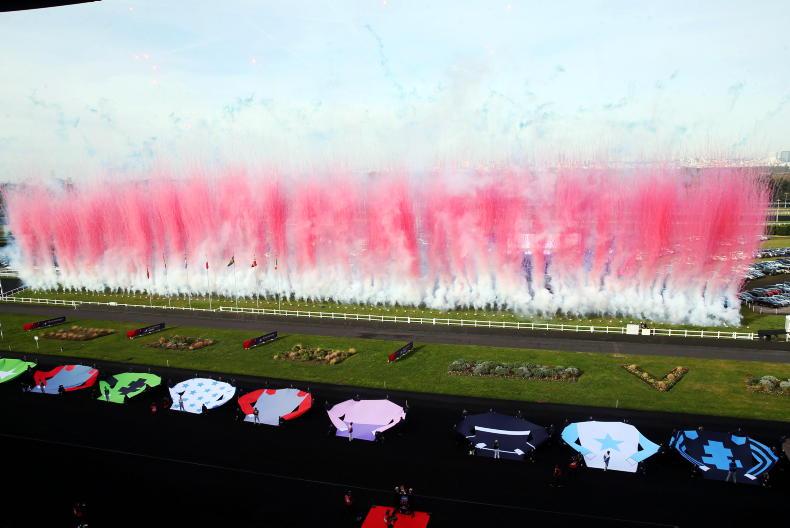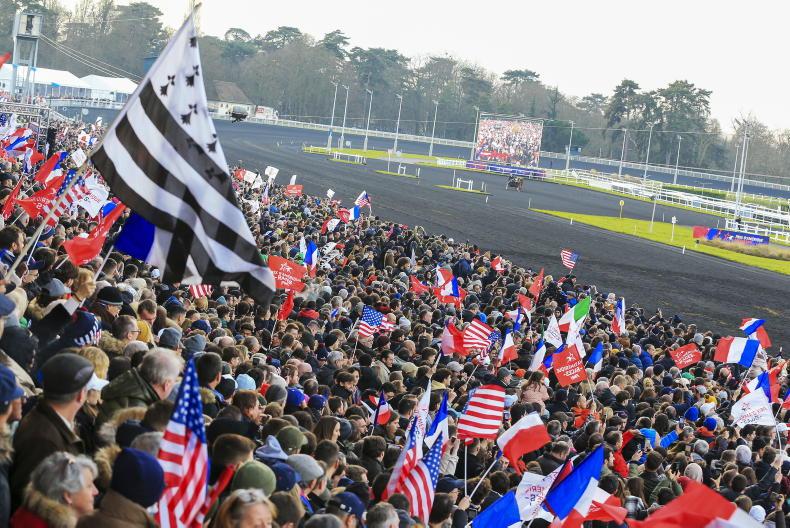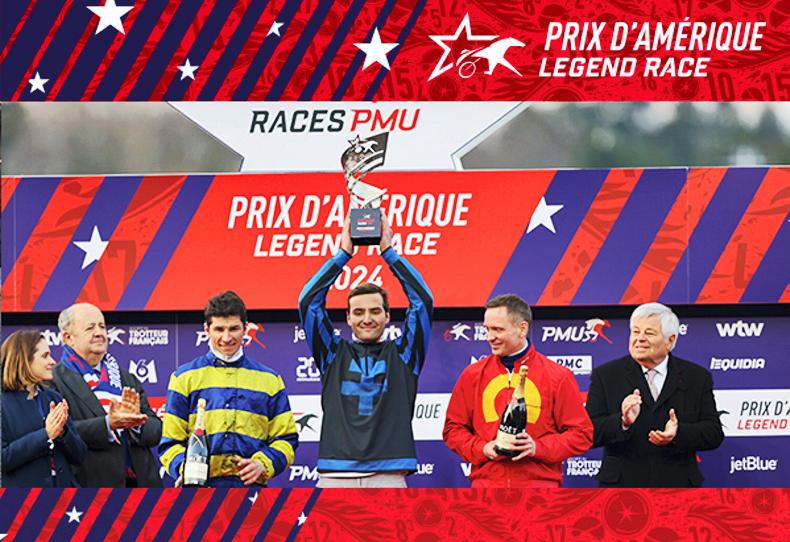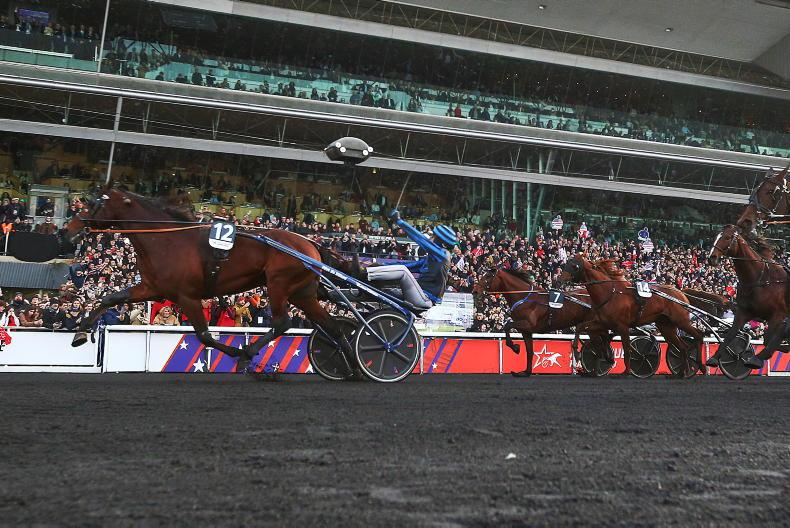Prix d’Amérique
THE 103rd renewal of Europe’s premier trotting race went the way of the 15/8 favourite Idao de Tillard.
The six-year-old entire has been a revelation this season and was heavily tipped by both the French experts and some Irish horsemen in last week’s preview.
Sean Kane, from the Naul, has worked in Sweden and a few winters in France. Sean’s father, Ger, has the largest string of Trotteurs Français in Britain or Ireland, so it’s no wonder that Sean keeps a keen eye on the French form.
Sunday’s winner was disqualified in the big race 12 months ago, but Sean did tell The Irish Field last week that the addition of a head pole had helped Idao to trot straight and true. A ‘head pole’ runs from the ‘saddle pad’ at the horse’s withers to a ring on the inner bridle. The theory is the device stops horses boring in or out, depending whether the pole is used on the animal’s near side or off side. Head poles are used a lot in America, but are unusual on the French scene.
However, they arrived at it, this was a popular victory for the Duvaldestin family, one of the glamour outfits of French trotting. Prior to Sunday, trainer Thierry Duvaldestin was best associated with the great Ready Cash who won the PDA twice (2011 and 2012).
Baton passed
The 26-year-old trainer’s son, Clément Duvaldestin, was in the bike. As with all forms of racing all over the world, the baton is passed on, and the next generation gets blooded. The 52-year-old Thierry Duvaldestin has a healthy weather-beaten look about him, that comes from early mornings on the training track. He was beaming with pride.
“We were nervous because he had a few setbacks in the run up to the race. He put in the best performance of his career,” said Thierry of the winner, who clocked a kilometre rate of 1.11.6 over the 2.7kilometre (1m7f) test of stamina.
The French public seem to drop the middle syllable of Idao and “allez Eedoo”was how it sounded as the 35,000 strong crowd roared home ‘le favouri’. It was difficult to find a PMU machine without a queue, which is important as the Pari-Mutuel organisation were the main sponsor.
The winning distance of one length probably flattered the runner-up, rank outsider Hokkaido Jiel at 90/1. Duvaldestin was in no hurry in the middle of the 18-horse pack. The young driver got out with around 500 metres to go and could have won further.
“I told Clément wherever he was in the field to sit content,” said Thierry in post-race comments.
“It was some result to be second in this company,” said second placed driver David Thomain.
Joviality (third) put in a massive run for a five-year-old mare against males. The press was very complimentary about the ‘trip’ that the soft-spoken Swede Bjorn Goop gave the mare.
Bjorn said: “I thought I made second but David got up. I’m looking forward to next year. I think the winner is the best horse in the world right now.” As Goop has contacts in Sweden and the USA, his comments are weighty.
The fourth horse, Go On Boy, caught the eye. Watch the replay on Le TROT website, or ATR, and he was flying at the finish for Romain Derieux.
The Irish Field selection Ampia Mede SM could only manage seventh of 18, which meant (not for the first time in my punting career) that austerity measures were introduced.
Idao de Tillard was a €27,000 yearling. He is owned by M. C. Sevestre and has now won €1.9 million. The all-important groom is Susanne Ohme, originally from Norway.
THE Willie Mullins of French trotting, Jean Michel Bazire, provided the favourite in four or five of the races over Saturday’s nine-race card and Sunday’s 11 races. ‘JMB’ who still drives frequently himself won with one favourite on Saturday and one on Sunday.
The Saturday winner was a piece of clever placing. Jushua Tree (a five-year-old) had actually qualified for the big race on Sunday, which is an all-age affair.
However, Bazire ducked the ‘AmÉrique’ and kept the stallion to his own age group in the Prix de Bold Eagle.
Three minutes later and €135,00 to the owners and yet again the Parisians were shouting ‘bravo Jean Michel’ as he landed odds of 1.30 on the PMU. In the press room, the scribes were talking of Jushua Tree for the Prix d’Amérique in 2025.
The impish Eric Raffin winner of the Sulky d’Or (leading driver) 2023 had a few winners over the weekend.
Franck Ouvrie who has dominated the Red John Festival in Clonakilty in 2023 and 2024 had a blank weekend.
Le TROT the official promotional body for the racing and breeding of the Trotteur Français breed, really excelled themselves at Vincennes last weekend. The massive race card went off with the customary Gallic strictness. As well as the ‘Holy Grail’, there were four or five group races on the undercard both days.
Guided tours of the Grosbois mansion (Newmarket for trotters) were available. Jazz bands, clowns on stilts and all the modern-day street food were laid on for the non-hardened racegoer. The colossal complex nine miles north of the city centre hosted 35,000 people. Of course, there were queues for betting, drinks, food and toilets but nothing so slow as to warrant a complaint.

After racing on Saturday the excellent Driss Farrio and his band knocked it out of the park with brilliant cover versions: six female vocalists, horns, the lot.
Unique
Everything that makes French harness racing unique was on show. The French believe that their breed is sturdier than the American Standardbred because they have kept up their tradition of saddle (monté) races. Around 20% of the card was for this form of trotting.
Eric Raffin was busy changing from his driving trousers to breeches and soft boots for the ridden job. He competes both in the sulky and saddle as do the Abrivard brothers.
Eric Rafffin won the Sulky d’Or as leading sulky driver in 2023. Alexander Abrivard was awarded the Etrier d’Or (Golden Strirrup) as leading monté jockey in 2023. The latter broke a leg in a horsebox crash recently and missed the big meeting.
Most of the races (sulky and ridden) including the Prix d’ Amérique itself are started by the ‘volte’ start. Basically, this is a turning start where the runners circle around a huge apron area adjacent to the track and then fan out onto the main ‘piste’ as it’s known in French. The mobile starting car, so popular in these islands and America is used sparingly.
Dark art
The volte start is a dark art. Having spoken to several Irish drivers who have driven in this method, there are different ways of playing it.
There is no draw as such, you go where you feel like. Obviously, if the driver stays near the rail he will get a shorter trip. However, if your horse is fractious at the start, a possible galloper, some drivers feel they are better on the outside of the turning circle of horses as they can get on a longer stride (think of a spiral staircase).
It appeared that quite often the early leaders started on the outside of the pack and then crossed over before reaching the first bend. The track is easily 100 feet wide so there are few hard luck stories, at least at the start.
As with all the ‘driver colonies’ throughout the world, there is an unspoken understanding between professionals. Over the big weekend there was not one inquiry due to interference.
Crouch forward
Up until around 25 years ago the monté jockeys rode with their stirrups at full length, but these days they crouch forward like jockeys on the flat. The Belgian-born jockey Philippe Masschaele revolutionised saddle trotting around 2000 when he started to sit forward – 100 years after Tod Sloan on the flat!
The ridden horses wear tail cruppers. Most of the runners use a double bridle, and fearsome looking bits. In Ireland and Britain, trotters are usually ridden with a snaffle. The French are the world leaders at saddle racing.
The stewards use a minibus with windows and seats at right angles to the moving field and they can watch all races intently. Once a horse is disqualified for galloping, a siren is sounded and almost instantly the offending runners number goes up on the big screen also.
Finally, by way of explanation, people watching trotting for the first time might have noticed certain drivers chasing on a horse that is galloping. The stewards encourage drivers to move forward swiftly once a horse has been disqualified.
The theory is that a driver trying to steady a horse in the middle of a bunched field could cause a ‘domino effect’ in behind. Where a gap exists, the driver must take to the outside.
This much said, the majority of horses at the weekend stayed trotting, and rapidly at that. The better races averaged out at 1.11 for the kilometre (a 1.54 mile rate).

THE atmosphere is helped by the organisers who give out flags and baseball caps in the individual colours of each of the 18 runners in the feature race.
The opening ceremony is one of the reasons to travel to Paris. In 2022 and 2023 the trophy was delivered by a parachute. This time the organisers tried something different. The track is cleared for the ‘show’. Eighteen teams of young people came onto the track carrying what appeared to be long planks or beams.
Firstly, the head of Le Trot M. Jean-Pierre Barjon and retired trainer Jean Lou Peupion bring the trophy out of a tunnel onto a red carpet. Then, as in previous years, each driver is introduced to the crowd and comes down the red carpet. The mood is not unlike the ‘walk on’ at a darts match or boxing bout.
Meanwhile, as each driver comes onto the track, the beams get ‘unfurled’ to reveal a 20 metre x 20 metre cloth replica of that driver’s colours. Over the top? Yes - but it works.
A short but spectacular fireworks display then follows. Happily, the stable block is a good bit away from the ceremony. Maybe it’s no coincidence that many of these trotters wear ear plugs!
National anthem
Things eventually calm down with the more common group photo of the participating drivers, the playing of the national anthem and a display by the Republican Guard. One more standard race is held before compere Laurent Bruneteau whips the crowd up into a frenzy again before the main race.
It’s unlikely that We Will Rock You or Seven Nation Army will be played at full volume over the PA system at the Dublin Racing Festival this weekend, but I saw and heard.
The former president of France M. François Hollande was guest of honour. In trotting terms, the now retired John Campbell from New Jersey (10,000 winners - $300 million in prize money) represented the United States.
John is president of the Hambletonian Society in the USA. He was accompanied by Moira Fanning, a great source of American archive material for this column.
A decent-sized Irish contingent was in attendance. Mark Flanagan, chairman of the Irish Harness Racing Association, led a delegation to the European Trotting Union meeting on Saturday morning. Mark was interviewed on the winners’ podium on Saturday about Ireland’s work with Le TROT.
In matters of administration, TROT Britain, the arm of trotting as opposed to pacing, has now been admitted as a full member to the UET.
The admission of Britain is the 22nd member state and should simplify links with Ireland.
FERGUS ‘Fergie’ Gosson, from Balbriggan, Darren ‘Chicken’ Keegan from Cabra and Philip ‘Buster’ Gilligan from Swords were in town for the big race. As we can tell from the colourful nicknames all three trotting men are true Dubs.
Local hawkers were selling tipping sheets in French or English (known as Pronostics or Pronos). Paris Turf publishes a bumper issue. TV Channel Equidia and various radio stations bark advice at racegoers all day long. Every driver and trainer are interviewed about their chances.
Syndicate
But Fergie, Chicken and Buster do their own thing. In the opener their little syndicate goes for 11/1 winner Fergie Highland, “because of Fergie’’. Two races later they pick another 11/1 winner ‘Facetime’ for the reason “Fergie is never off Facetime”.
When you are on a lads’ weekend at the races a 140/1 double is a nice cushion after three races. The last reports from Paris were that Buster was taking the guys to a well-known steakhouse on Sunday night “to buy half a cow”.

Who needs tipping sheets anyway?
THE Duvaldestin family trained the great Ready Cash in the latter stage of his career. The winning driver Clément and his brother, Theo, who also drives professionally, were only 10 and 12 at the time of their father’s last Prix d’ Amérique winner.
For 25 minutes after the race young Clément was public property. Everybody needed a piece of him. TV, radio, newspapers naturally wanted the heat-of-the moment reaction. 30,000 spectators were going mad.
Just by chance, father and son Kevin and Adam Corey from Glengormley, and I happened to be passing the Duvaldestin block of four stables in the racecourse yard, as the winner was led back for a post-race wash.
A crowd of around 60 close family, friends and neighbours had gathered in the privacy of the little corner.
Away from the chaos of the main track, a lovely impromptu round of applause broke out. Despite the language barrier, the Coreys and I knew we were seeing a special moment. A relieved quip from Clément, much laughter from the small gathering and down to washing the horse and getting their next runner ready.
Despite all their many successes in European trotting there was a family feel to this win. The winner’s circle photos with plenty of babies and toddlers were reminiscent of Annaghmore.




 This is a subscriber-only article
This is a subscriber-only article
 It looks like you're browsing in private mode
It looks like you're browsing in private mode








SHARING OPTIONS: